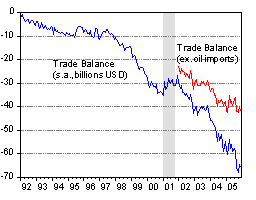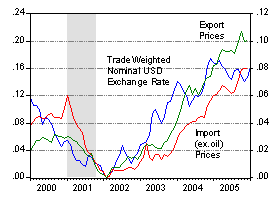The trade deficit (total and ex-oil) widens again.
The BEA and Census released the December 2005 trade figures this morning, with the monthly trade deficit of $65.7 billion exceeding the Bloomberg consensus of $65 billion. Bloomberg continues:
The U.S. trade deficit widened to a record for a fourth straight year in 2005 as Chinese imports poured in and energy prices jumped to their highest ever.
American companies imported $726 billion more goods and services than they exported last year, the Commerce Department said today in Washington. The shortfall in December increased to $65.7 billion from $64.7 billion a month earlier.
Improvement in the trade deficit this year may prove difficult because the U.S. economy is stronger than most of its trading partners, economists said. China accounted for more than a quarter of the total U.S. deficit last year, the most for any country, eliciting a chorus of criticism from lawmakers about the Asian nation’s trade and currency policies.
The difficulty in adjustment is presaged by the continued downward march in the trade balance, even after taking out the effect of petroleum imports.

Source: BEA and Census December 2005 trade release.
As Brad Setser notes in his post on the subject, part of the news in the release is the continued deterioration in the ex-oil trade balance.
The numbers typically reported in the trade announcements are nominal values. Another way of looking at the data is to examine real exports and imports (this can’t be easily done with the NIPA data since those aggregates are chain weighted). Using the BLS’s end-use price indices (which are Laspeyres), I have deflated the exports and imports in order to calculate the real goods trade balance.

Source: BEA, Census, December 2005 trade release; BLS, and author’s calculations
This shows that the deterioration in the measured US dollar trade balance has not been mostly a valuation effect (which would show up in a wide divergence in the nominal and real series), but rather increasing quantities of imports relative to exports. (Note: The series do diverge if one examines the trade balances including oil.) There is some gap during 2003-2004, as the dollar depreciates. but in the last months of 2005, whatever deterioration in non-oil trade balance occurs is due to real quantity movements.
Finally, the last reason to project further deterioration in the 2006 trade balance figures is that 2005 witnessed appreciation in the nominal US dollar in broad terms, in the next figure (all series logged, and normalized to zero in February 2002).

Source: Fed and BLS (prices for export goods, and import ex. oil).
As illustrated above, import prices have risen about 8% for 16% dollar depreciation, while export prices have risen about 10% (all expressed in log terms). The relative stability of the dollar over the last half of 2005, in contrast to 2002-04, suggests that tradables prices will not necessarily continue to move upwards as much as before. This will tend to reduce the (trade balance) stabilizing influences of higher prices. Then improvement in the trade balance will have to be driven by acceleration of rest-of-world growth relative to that in the US.
Technorati Tags: trade deficits,
pass through
Fortunately, we have have what looks like a durable recovery in Japan and nice signs of pick-up in the euro-area.
If US growth slows a little, perhaps as a consequence of less aggressive house price inflation and higher interest rates, and the euro area and Japan pick-up, then forces would be working from both sides to support the idea of a narrowing growth differential, which could help slow the deterioration in the US’ external balance.
I know the metrics point to a widening deficit over time (ie a continutation of the trend), but this scenario could provide a little temporary relief, especially if supported by declining oil prices (lower energy import bill).
PS – I don’t know if the mkt is already buying in to a thesis along these lines, but the USD ended up nicely stronger on the day.
Abobtrader: Thanks for the comments. While economic recovery seems to be gathering steam in Japan and Germany (although France seems a bit more questionable), as Catherine Mann and Katerina Plueck have pointed out, acceerated foreign growth will have only small impact on the trade deficit. Substantial changes in the trade balance will have to come from the US side (although lower oil prices will definitely help for the total trade deficit).
agreed, perhaps we are seeing the culmination of factors from all sides that could help deficit a little. If my very quick read of the linked paper is correct, and the US savings rate is more important than relative growth differentials for the US c.account deficit, then a slowing in the housing could surely also help (there seems to have been a high correlation between the saving rate and appreciating house prices).
I am not overly optimistic, but I just can’t see the trade deficit forever widening without self-corrective mechanisms coming in to play.
Thanks for giving us a view of the import/export quantities MC, suggesting that the balance is more than a reflection of current prices and that the trend is not going to be righted by, say, a revised tariff schedule.
This:
Then improvement in the trade balance will have to be driven by acceleration of rest-of-world growth relative to that in the US.
sounds like the US growth taking a recess rather than Japan or Germany or China or ? finding some new ‘over-drive’.
Abobtrader: I agree — the economy is a self-correcting mechanism; the issue is whether policy can make the correction less abrupt and painful. Or indeed whether policy (fiscal for example) is making the adjustment in the end more costly than it need be.
Calmo: I think that what will need to happen for a reduction in the trade deficit is some slowdown in US GDP growth — which everyone predicts — is necessary. The extent of the slowdown depends in part upon the pace of growth abroad — especially the big economies like the euro area and Japan. In addition, the composition of output will have to change, with domestic absorption (consumption, investment and government spending on goods and services) declining and net exports rising.
My worry has been, and remains, that with a relatively small tradables sector, adjustment from a 6.5 current account deficit will not be as easy as the 3% deficit in the mid-1980s, globalization notwithstanding.
The question of whether America will see economic turmoil in the near future depends largely on future consumption, savings, and government spending decisions. If the American deficit is brought under control, then the position of foreigners is not as important. Otherwise, the American deficit can continue as long as investors or central banks are willing to put their surplus savings into America. For the near future, this seems to be what will happen. Gradually, foreigners may reduce the level of savings that they commit to America, which would put strain on the America economy. If America lowers its desired deficit position in tandem with foreigners decreased willingness to purchase American bonds, then a hard landing could be avoided. The debt-to-GDP ratio will be a determining factor, which will become a problem in the long-run if the deficit continues. For these reasons, the deficit must lower in the future, but there is no immediate need for this.
It recently has ocurred to me that the US is experiencing the “Walmart” phenomena at a national level. The entry of Walmart into an established local or regional market instantantly provides an alternative, competitive supply chain, making the established infrastructure, redundant. Those businesses that cannot compete on price, convenience, and diversity of products, go out of business or adapt a specialized, complementary niche, ceding the dominant market share to the mega-competitor.
On the bright side for consumers, a greater variety of products are available, at lower cost, and at greater shopping convenience.
On the dark side, the average local wage rate and overall employment tends to be depressed, demand on government resources increases, local manufacturing and other industrial services tend to be reduced, as are tax receipts.
The net economic effect of the Walmartization process is generally thought to be negative, resulting in a reduced standard of living for the region as a whole.
It is fitting that the current trade deficit is related to off-shore manufacturing to supply Walmart and other industries forced off-shore by the tidal wave initiated by Walmart. It is interesting to look at the parallels between the current US national economy with the regional and local economies experiencing the “Walmart” phenomena. A declining manufacturing sector, encumbent industries failing (GM, Ford), increasing demand on government services (health care crisis, budget deficit), declining or static average wages, anemic job growth, increasing underemployment, pressures on teh pension system, less than stellar stock market performance, and less than stellar GNP growth, after consideration of the degree of monetary and fiscal stimulus applied.
Perhaps, to gage the ultimate effect of the “free trade” policies that have resulted in the lion’s share of this deficit, we can simply quantify the effect that Walmart has on a local or regional economy.